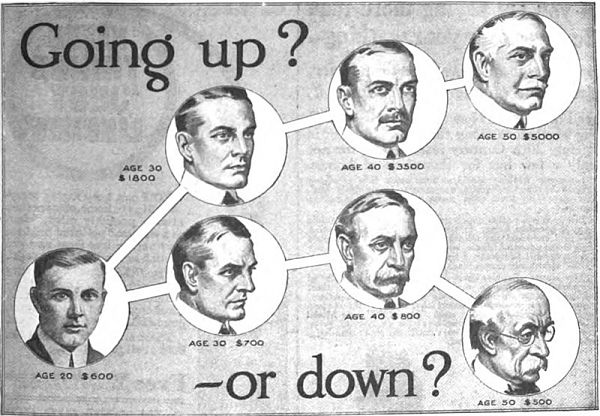 Public Policy
Public Policy It’s Time to Take the Measure of Social Mobility

In the rags-to-riches land of Horatio Alger, social mobility isn’t an automatic part of the U.S. conversation in the same way it is in other industrialized countries or as other indicators, say unemployment or GNP, are expected to be present.
And yet the ideas that underpin ‘social mobility’ are part of the nation’s own creation myth. “One of the deepest commitments of this country,” argues Stanford sociologist David Grusky, “a commitment that reaches back to the founding documents, is the commitment to equal opportunity. All children, no matter how poor their parents may be, should have access to opportunities in the labor market. That’s fundamental.“
The last time the United States saw a large-scale survey on the issue was in 1973. Ironically, inspired by the US’s strong example in the 1960s and 1970s, other countries have forged ahead with their own standing –and continuing — measures of mobility, such as repeated cross-sectional surveys in Japan, panel surveys in Germany and register data in Sweden.
None of which is to say it’s not a part of the conversation in the U.S.; social mobility often enters as an amorphous talking point that often reflects the sensibilities of the speaker (It’s stable! It’s down!) more than the message of the underlying data.
That fuzziness follows from that lack of infrastructure for measuring social mobility, and even though many metrics of the concept are inherently measurable. Because it hasn’t been institutionalized as a measure, said Grusky, some sort of opportunity or mobility measure doesn’t enter the national narrative in the same way that unemployment does. “If you had that measure, I think it would fit very naturally” into that narrative. but
In a just released article, Grusky and two other academics, economist Timothy Smeeding and sociologist Matthew Snipp – described as “the Three Musketeers of mobility data collection” by Richard Reeves– propose a new standing measure of mobility, something they dub the American Opportunity Survey. The trio were part of a National Academy of Sciences roundtable on designing a new national measure of mobility convened in 2013 (another key player was Robert Hauser, part of that 1973 effort).
This month a special edition of The Annals of American Academy of Political and Social Science, co-edited by the Musketeers, appeared with a suite of articles dealing with various aspects of this measurement deficit and most saliently, with a specific recommendation from Grusky, Smeeding and Snipp for the American Opportunity survey, or AOS. (The issue also includes a version of Nobel laureate economist Joseph Stiglitz’s speech on income inequality delivered last year as part of the AAPSS’s Moynihan Awards ceremony.)
In a sort-of ‘the AOS is dead, long live the AOS’ moment, they call not for a brand-new stand-alone survey, but instead for linking to the wealth of administrative data already being collected that might be tapped and tweaked to deliver useful and routine information on U.S. mobility. “What makes this proposal so attractive is that we’re relying on existing products that have a rationale in and of themselves, and we’re simply further exploiting that,” Grusky explained in a phone interview with Social Science Space. There’ a shining example of this approach – Raj Chetty and company’s recent look at mobility using US tax records.
Among the products informing the AOS would be the national Census, the American Community Survey and yes, tax records. Grusky sees three reasons – politics, technology, and guilt –as pushing this initiative forward now:
“It’s a fascinating time. The political interest in issues of mobility has ramped up. I think it’s because Obama and other Democrats realized that an anti-inequality program is going to be controversial from the get-go, and while Obama toyed with that sort of program, at the end of the day he’s settled on an equal opportunity commitment because he believes that that resonates more widely.”
Meanwhile, the tools of Big Data create the ability and capacity to exploit linkages to government administration that hadn’t been possible before. And social scientists, he added bluntly, have a debt to discharge – “we dropped the ball in respect to mobility surveys.” But that fumble has created an opportunity now to craft a better structure than an ongoing survey was likely to have produced.
In a feasibility assessment of the AOS that concludes the special issue, Kenneth Prewitt, former director of the Census, keeps the pressure on the academy, and not the policymakers, to pursue this vision. “Getting the science right,” he said, “is a necessary but not sufficient step in getting it used.”
Grusky said the project is looking for foundation support right now, and there are some legal and privacy issues that need to be addressed. “It’s not in implementation yet, but it is in development,” he explained. “We want to make it happen. Until someone tells us to stop, we’re going to keep going.”
Below is a condensed version of the conversation Grusky had with Social Science Space.
Why would I care about social mobility?
We, quite surprisingly I think, have not set up a framework to monitor this, and that’s very different from other well-off countries who don’t have as deep a commitment to that equal opportunity principle, and yet they monitor it in a regular way.
That’s not the only reason, of course, but it’s an important one. Efficiencies in the labor market hinge on making good matches between the talent and what the job demands. If you have a highly inertial system, then those sorts of good job matches just can’t be mad. Even if you didn’t have any commitment to the principle of equal opportunity, you would have a commitment to mobility so those good matches could be made.
What about having the tools to measure mobility?
We don’t have the infrastructure we need to monitor how much mobility there is. The last comprehensive survey dedicated to where [the United States] stands in social mobility took place in 1973. Most countries have repeated cross-sectional surveys at regular intervals — every five or 10 years — to assess where they stand. We dropped the ball, as it were, and since 1973 we’ve done nothing. So that puts us in a real handicap, where we have to rely on very small surveys, and not dedicated surveys, to assess where we stand. We just don’t have the sample size to determine if there’s been an increase or a decline in social mobility. Lots of the people, the president included, are worried that there’s a decline in social mobility, but we can’t monitor if that’s been the case.
Now there are administrative data as well, most importantly tax return data, and those are immensely useful, but there’s a host of problems that make it impossible to rely on them exclusively.
But I see articles in the mainstream media comparing social mobility in the US with other countries …
Those cross-national comparisons are usually founded on survey data, and based therefore on very small samples. Because the US is quite different from other countries in the amount of mobility, we can often get significant differences between the US and other countries even with small surveys. Those surveys typically speak only to one kind of good, economic mobility, which allows those comparisons.
There has also been a very small literature on trends in mobility in the United States. In particular there was a piece a year ago that Raj Chetty put out that relied not on surveys but on tax return data, but because those data allow us to speak to very recent trends — only in 1987 did the parent have to submit the Social Security number of their children to claim those children as dependents – we can’t really get the time series that we need to assess whether mobility is declining.
What do we want to measure? I assume that has changed over what we might have wanted in 1814 or even 1914.
There are several kinds of mobility that are key to developing a comprehensive understanding of where the country stands. Just as you can’t measure labor market participation with any single measure, with social mobility you need a series of measures to really nail where we stand. But one key measurement is the extent to which lifetime earnings of a child reproduces that of his or her parents. You want in an ideal world to know what the lifetime earnings of the parents are, and then the same for their children, and see to what extent there’s a strong correlation between the two. It’s very hard to realize that ideal; there are a variety of statistical techniques to do so.
We also care about occupational mobility, since one’s occupation often signals in a more compelling way what one’s life is really like. People within the same occupation often share a very similar style of life, a very similar set of opportunities, so examining the extent to which the child’s and the parents’ occupations are the same or not gives us another very important indicator of how much mobility there is.
You and your co-authors describe creating something you call the AOS, the American Opportunity Study, to measure mobility. But you’re not talking about a new Office of the AOS, with stationery, etc., but using or repurposing existing tools and assets.
Absolutely. What I think makes this proposal so attractive is that it’s consistent with the Paperwork Reduction Act! We exploit existing data collection capacities already in play and in a very cost-efficient way, simply linking to existing data to address how much mobility there is. No new data collection would be needed; it’s just a matter of using existing tools.
Such as the American Community Survey. But there are people out there who seem to not like the American Community Survey. Are there people out there who do not want to see these figures on social mobility out of fear that they think they know what they’re going to see and they don’t want to see that?
There are some, yes, just like there are some who don’t want to see poverty data, which then might lead to a cry for programs to address poverty. Likewise, there are folks who might not want to see mobility data. But I think the actual number of such folks, when push comes to shove, is actually quite small. There is nothing more conventional than this commitment to equal opportunity. No one in the U.S. would openly say they’re not in favor of an equal-opportunity regimen. That’s a central commitment. Lots of people would say I think there should be less or more inequality, that’s a highly debated issue, but not the commitment to equal opportunity.
When talking about ‘inequality’ and ‘mobility,’ are they the same concept?
They’re very different beasts. One is just about the total amount of income inequality you might see at any given moment and the other is the share of that inequality that arises from intergenerational transmission mechanisms.
What happened to drop that ball in 1973?
Part of it was a feeling in academia in the 1960s and 70s that it was very fashionable within social science to study mobility. There was a little bit of a backlash against that in the 80s and 90s, and that backlash was especially prominent in the US. [Outside of the US] there was band of social scientists who were able to successfully argue for a continuing commitment to monitoring mobility, whereas I think social science in the US is to be blamed for failing to put on pressure of a similar sort. I also think it’s just harder in the US for social science to be successful because it seems more suspect than it is in other countries. Still, I think mainly we’re to blame as social scientists for failing to keep the pressure up; we’re trying to rectify that a bit.
I would say sociology has been especially complicit here, in what has historically been the discipline that’s very committed to studying mobility. Also economics. [But] economists have been very important in bringing it back to the forefront, Raj Chetty and his team in particular doing important work. So economics has to its credit led the charge to bring this back front and center while sociologists are still not doing as much as they should.
What did you and your co-editors learn from putting together this edition of the ANNALS?
When we started, we believed we would simply launch another survey and carry on this tradition of having dedicated surveys. The last one was in 1973 and we thought it was high time to do another. We went in thinking we would mount another survey effort, perhaps again using the Current Population Survey as the foundation as was the case in the past..
What became clear was that that was old-fashioned. After as comprehensively as possible weighing all the options, what became very clear was that it would be wasteful to launch another survey. It would be much better just to link.
Of course there are complications. Some people will worry about privacy and security issues. We’ve tried to take into account as much as possible such concerns. That’s a downside, not that I think there are any new security privacy issues that arise as a result of this initiative, but there might be perceptions that there are.
How did you become one of the ‘Three Musketeers of data collection’?
My own lifetime has been a very deep illustration of inequality of opportunity. My grandfather was a sociologist, my father is a sociologist, and now me. That has sort of captivated me – how could it be that that sort of reproduction could happen? I mean, the total population of sociologists is extremely small, right? It defies an argument that this is just chance! In fact I’ve done some research on this, and there’s a lot of reproduction among professors, among doctors, lawyers. At the top of the professions you have a lot on inequality of opportunity, but that sort of inequality extends across the board.
Families are so different from what’s come before. Even the definition of a breadwinner has changed. How difficult is that to account for in this kaleidoscopic backdrop?
That was a very important reason we thought the structure we’re proposing dominates the other options, precisely because we need an infrastructure that can reflect changes in complications of family structure. If this were to be realized in the glorious form we have laid out, we would have measurements say of ‘Who is serving as one’s economic parents?’ and traces of that could be discerned through tax return data. We would also have measurements of social parenthood that arises from say co-residence that could be picked up through the Census or ACS. We could find out if kids were actually living with particular adults and whether or not they were the biological or tax parents. You’d have both these two kinds of parenthood and you’d have them both over time – each ACS, each decennial Census, each tax-return year. This would be a patchwork, Swiss cheese sort of affair – we wouldn’t have measurements on everyone every year – but we would have the ability to piece together much more information than would ever be possible via a single cross-sectional survey. You could really see how these family structures change over time and we could then relate that to mobility. We could see how changes in family structure are bringing about changes in mobility, which is a very, very common hypothesis.
How do we account for immigrants, where we might not have the data?
This is one area where our proposed infrastructure is perhaps not all that one would like. As new immigrants flow into the U.S. they will be represented in the ACS and the decennial Census or possibly in the tax system, so we’ll have this self-propagating, self-refreshing panel. In a typical panel you have problems as it becomes ever-less representative of the population as the structure of the population changes through immigration and other reasons, but in our set-up at least it would have this self-refreshing structure.
The problem is, if children don’t come with their parents, we won’t be able to ascertain (through the methods we’ve discussed) the occupation of the income status of the parents. That’s one case where you have to have a stand-alone survey of those immigrants where you ask them what their parents are doing in their country of origin and then try to assess their mobility that way.
Nonetheless, I’m taking it for granted that for the AOS the goal is not to let the perfect get in the way of the good at this point.
Exactly. I would say that [the immigration question] is really the biggest deficiency — and we can deal with that.




























































































